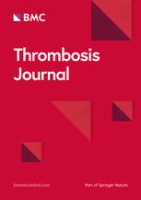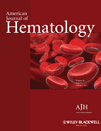
Thrombosis Journal
Scope & Guideline
Pioneering open-access discoveries in thrombosis.
Introduction
Aims and Scopes
- Clinical and Epidemiological Research on Thrombosis:
The journal publishes studies that investigate the prevalence, risk factors, and outcomes associated with venous thromboembolism (VTE), arterial thrombosis, and related conditions across diverse populations. - Innovations in Antithrombotic Therapy:
Research on the efficacy and safety of various antithrombotic agents, including direct oral anticoagulants (DOACs), low-molecular-weight heparin (LMWH), and vitamin K antagonists, as well as novel therapeutic strategies. - Mechanisms of Coagulation and Fibrinolysis:
Studies exploring the molecular and cellular mechanisms involved in coagulation and fibrinolysis, including the role of inflammatory markers, genetic factors, and biomarkers in thrombotic events. - Thrombosis in Special Populations:
Research focusing on thrombosis in specific populations, such as pregnant women, cancer patients, and those with comorbidities like COVID-19 or renal insufficiency, emphasizing tailored management strategies. - Guidelines and Risk Assessment Models:
The journal emphasizes the development and validation of clinical guidelines and risk assessment models to optimize thrombosis prevention and management in different clinical settings.
Trending and Emerging
- Impact of COVID-19 on Thrombosis:
A significant increase in research related to COVID-19 and its association with thrombotic events is evident, highlighting the need for understanding the mechanisms and management of thrombosis in infected patients. - Machine Learning and Predictive Modeling:
There is a growing trend towards the use of machine learning and advanced statistical models to predict thrombotic events and personalize thromboprophylaxis strategies, indicating a shift towards data-driven approaches in clinical practice. - Role of Inflammatory Biomarkers:
Research focusing on the relationship between inflammatory markers and thrombotic risk is gaining traction, reflecting a broader understanding of how inflammation contributes to thrombotic pathophysiology. - Thrombosis in Cancer Patients:
An increasing number of studies are addressing thrombosis in cancer patients, particularly regarding thromboprophylaxis during chemotherapy and the management of cancer-associated venous thromboembolism. - Personalized Anticoagulation Strategies:
Emerging research is concentrating on personalized anticoagulation management, including genetic testing and individualized dosing strategies to optimize treatment outcomes.
Declining or Waning
- Traditional Risk Factors for Thrombosis:
Research focusing on conventional risk factors such as obesity and immobility is declining as newer studies explore genetic, molecular, and inflammatory markers that provide deeper insights into thrombosis mechanisms. - Single-Agent Antithrombotic Studies:
The focus on studies evaluating the efficacy of single-agent antithrombotic therapies is waning, giving way to research that examines combination therapies or multi-faceted approaches to thrombosis management. - Basic Science without Clinical Application:
There is a noticeable decline in purely basic science studies that do not translate into clinical applications, as the journal increasingly prioritizes research with direct implications for patient care. - Historical Perspectives on Thrombosis Management:
Papers that review historical approaches to thrombosis management are becoming less frequent, as current research emphasizes evidence-based practices and innovations in treatment.
Similar Journals

Arterial Hypertension
Transforming knowledge into practice for improved patient care.Arterial Hypertension is a dedicated Open Access journal published by VIA MEDICA, with the ISSN 2449-6170 and E-ISSN 2449-6162, focusing on the multidisciplinary field of cardiology, endocrinology, and internal medicine. Established in Poland, this journal has been providing researchers and healthcare professionals with accessible, high-quality content since its inception in 1999. With a commitment to advancing knowledge in the management and treatment of arterial hypertension, it publishes significant research findings, clinical trials, and reviews that contribute to improved health outcomes. Though classified in Q4 across various relevant categories, the continuous improvement in its content ensures its relevance in an evolving medical landscape. Designed to facilitate collaboration and innovation, Arterial Hypertension serves as a crucial resource for anyone invested in cardiovascular health, encouraging open dialogue and dissemination of vital research within the scientific community.

Research and Practice in Thrombosis and Haemostasis
Advancing knowledge in thrombosis and hemostasis.Research and Practice in Thrombosis and Haemostasis, published by Elsevier, is a prominent open-access journal dedicated to advancing the field of hematology through high-quality research and clinical practice. Since its inception in 2017, this journal has established itself as a vital resource for researchers, healthcare professionals, and students interested in thrombosis and hemorrhage management, showcasing original research, reviews, and clinical studies. The journal’s commitment to accessible knowledge is reflected in its open-access model, allowing researchers worldwide to share their findings without financial barriers. With an impressive 2023 Scopus rank of #42 out of 137 in the hematology category and a respectable Q2 classification, it provides an authoritative platform for innovative ideas and cutting-edge developments in the field. As the journal continues to grow in stature, it aims to foster collaboration and knowledge exchange amongst professionals dedicated to improving patient outcomes in thrombosis and hemostasis.

CVIR Endovascular
Empowering Minimally Invasive Therapies Through Open Access KnowledgeCVIR Endovascular is a pioneering journal published by SPRINGERNATURE, dedicated to advancing the fields of cardiology, cardiovascular medicine, and radiology. Established as an Open Access platform since 2018, this journal has become increasingly pivotal for disseminating high-quality research that bridges clinical practice and innovative imaging techniques. With a robust focus on minimally invasive therapies and advancements in endovascular procedures, CVIR Endovascular serves as an essential resource for researchers, professionals, and students alike. The journal is indexed in key databases and holds notable rankings within its categories, specifically achieving Q3 quartile status in both Cardiology and Cardiovascular Medicine and Radiology for 2023. This positions it as an influential publication in the ever-evolving landscape of cardiovascular research. As it converges through the years from 2018 to 2024, CVIR Endovascular continues to strive for excellence, aiming to provide a platform for innovative findings and best practices that can enhance the future of endovascular care.

Journal of Hematology
Bridging Knowledge Gaps in HematologyThe Journal of Hematology, published by ELMER PRESS INC, serves as a pivotal platform for disseminating cutting-edge research in the field of hematology. With an ISSN of 1927-1212 and an E-ISSN of 1927-1220, this journal is committed to advancing scientific knowledge and clinical practice through high-quality peer-reviewed articles encompassing all aspects of blood disorders, from basic science to health policy implications. While the journal currently operates under a traditional access model, it nonetheless prioritizes the rapid publication of significant findings, ensuring that researchers, clinicians, and students have timely access to the latest advancements in hematological research. Positioned to bridge gaps in knowledge and foster collaboration among scholars worldwide, the Journal of Hematology is an essential resource for anyone invested in this vital area of medicine.

Journal of Vascular Surgery-Venous and Lymphatic Disorders
Elevating surgical excellence in venous and lymphatic care.The Journal of Vascular Surgery-Venous and Lymphatic Disorders, published by Elsevier, is a distinguished peer-reviewed journal dedicated to advancing the knowledge and practice of vascular surgery with a particular focus on venous and lymphatic conditions. With an ISSN of 2213-333X and a robust impact factor, this journal ranks Q2 in Cardiology and Cardiovascular Medicine and Q1 in Surgery, reflecting its high relevance and contribution to the field. Covering a wide spectrum of topics from innovative surgical techniques to the latest developments in venous and lymphatic disorders, the journal serves as a vital resource for researchers, clinicians, and students alike. It not only disseminates cutting-edge research but also promotes best practices and interdisciplinary collaboration within the cardiovascular domain. The journal is accessible to a global audience, ensuring that impactful findings reach practitioners and researchers everywhere, further elevating the standards of patient care and surgical excellence.

BLOOD REVIEWS
Exploring breakthroughs in hematologic and oncologic research.BLOOD REVIEWS is a highly regarded journal published by Churchill Livingstone, specializing in the fields of Hematology and Oncology. With an impressive Q1 ranking in both disciplines and placing in the top 10% of its peer categories according to Scopus metrics, it provides an essential platform for the dissemination of cutting-edge research and reviews pertaining to blood disorders and cancer treatment. Since its inception in 1987 and continuing through 2024, the journal has established itself as a cornerstone for healthcare professionals, researchers, and students who seek to advance their understanding of hematologic and oncologic topics. While not an open-access journal, BLOOD REVIEWS retains a reputation for delivering high-quality, peer-reviewed articles that foster dialogue and innovation within the scientific community. For those in the United States and beyond, the journal serves as a vital resource, housed at the Journal Production Department in Edinburgh, Scotland, ensuring accessibility and a global reach in its critical academic contributions.

AMERICAN JOURNAL OF HEMATOLOGY
Empowering Discoveries in Blood DisordersAmerican Journal of Hematology, published by Wiley, stands as a premier outlet for the dissemination of cutting-edge research in the field of hematology. With a commendable impact factor and ranked #9 out of 137 in the Scopus medicine category, this journal has established a robust presence since its inception in 1976. Operating in the Q1 quartile for hematology, it serves as a crucial resource for researchers, clinicians, and students dedicated to understanding blood disorders and advancing treatment methodologies. While the journal does not currently offer open access options, it remains highly regarded for its rigorous peer-review process and impactful contributions to the scientific community. With coverage extending into 2024, the American Journal of Hematology is committed to fostering innovation and collaboration within the hematological sciences.

PHLEBOLOGIE
Transforming Vascular Insights into Clinical PracticePHLEBOLOGIE is an esteemed journal published by GEORG THIEME VERLAG KG, serving as a critical platform for the dissemination of research in the field of Cardiology and Cardiovascular Medicine. Since its inception in 1991, the journal has consistently provided a comprehensive range of articles that explore the complexities of vascular health, offering insights into innovative treatments, diagnostic advancements, and emerging trends. Although currently not available as an Open Access publication, PHLEBOLOGIE maintains an impactful presence in the academic community, evident in its 2023 Scopus ranking as Q3 within its category and a percentile standing of 25%. Residing in Germany, PHLEBOLOGIE aims to bridge the gap between research and practice, appealing to researchers, clinicians, and students alike by fostering a deeper understanding of vascular conditions and their management.

JOURNAL OF THROMBOSIS AND THROMBOLYSIS
Unveiling breakthroughs in thrombolytic therapies.JOURNAL OF THROMBOSIS AND THROMBOLYSIS, published by Springer in the Netherlands, serves as a vital platform for research in the fields of Cardiology and Cardiovascular Medicine and Hematology. With an impressive impact factor, this journal ranks in the Q2 category for both fields according to the latest metrics, evidencing its significant influence and contribution to ongoing scholarly discourse. Spanning over three decades from 1994 to 2024, the journal provides an essential source for innovative studies, clinical practices, and comprehensive reviews related to thrombosis and thrombolysis. Researchers, clinicians, and students alike will find valuable insights and cutting-edge knowledge that address the complexities of blood coagulation and its implications in cardiovascular health. The journal is indexed in Scopus, with commendable rankings, further establishing its reputation in the academic community.

Annals of Vascular Diseases
Illuminating the Pathways of Vascular ScienceAnnals of Vascular Diseases is a leading international journal dedicated to the comprehensive exploration of vascular pathology, aimed at advancing knowledge in the field through innovative research and insightful reviews. Published by the ANNALS VASCULAR DISEASES EDITORIAL OFFICE and available in both print (ISSN: 1881-641X) and electronic format (E-ISSN: 1881-6428), this journal has embraced Open Access since 2017, facilitating wider dissemination and accessibility of vital research findings. With its focus on clinical and experimental studies relating to vascular diseases, the journal serves as a crucial platform for researchers, medical professionals, and students who seek to stay at the forefront of clinical advancements. By fostering collaboration and sharing knowledge, Annals of Vascular Diseases plays a significant role in shaping the future of vascular research and treatment strategies worldwide.